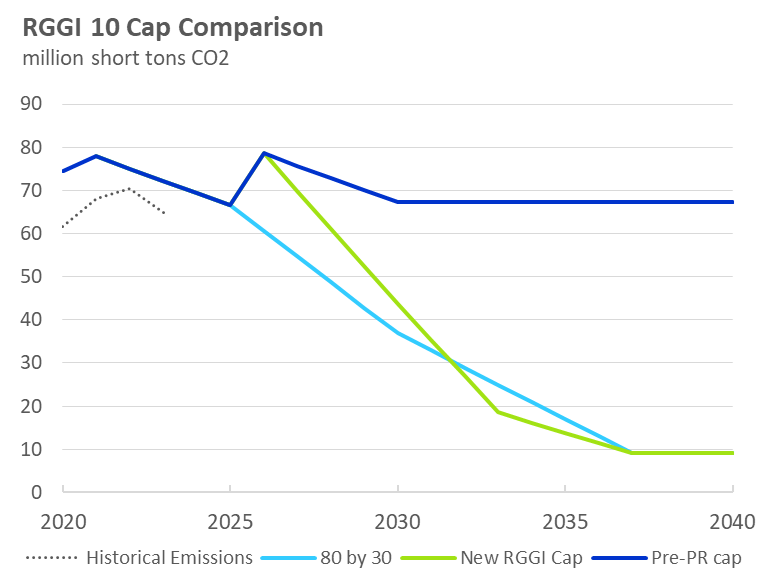On July 1, the ten states participating in the Regional Greenhouse Gas Initiative (RGGI) concluded their Third Program Review and announced updates that strengthen the regional cap on climate pollution, beginning in 2027. These changes also introduce new measures to protect energy affordability and reaffirm the program’s commitment to cutting pollution, promoting clean energy and supporting local communities.
As Environmental Defense Fund (EDF) analysis shows, the case for program improvements is well supported — delivering clean electricity and critical climate and health benefits while ensuring consumer affordability. And there’s still room to do even more.
RGGI’s history and its impacts
RGGI is the United States’ first multi-state, market-based program designed to reduce carbon dioxide (CO₂) emissions from the power sector. Launched in 2009, RGGI includes ten states across the Northeast and Mid-Atlantic that cap and reduce CO₂ emissions by requiring power plants to purchase allowances for every ton of pollution they emit. The proceeds from these allowance auctions are invested by the states in clean energy, energy efficiency, and consumer benefit programs — lowering electricity bills, improving public health and supporting local economies. RGGI has become a nationally recognized model for climate policy that combines environmental integrity with economic development and consumer affordability.
The recent changes to the program position RGGI to continue delivering environmental and economic gains that benefit over 8 million households and 400,000 businesses. With over $9 billion in auction proceeds invested in clean energy, $5.7 billion in health benefits, and $20 billion in energy bill savings projected, RGGI remains a model of what smart, collaborative climate policy can achieve.
A stronger cap, at a critical moment
Reducing power sector emissions by at least 80% by 2030 is critical to economy-wide decarbonization. The power sector encompasses many of the faster and easier decarbonization options in the near term, as resources like wind and solar electricity are proven technologies that can already be deployed at-scale and cost-competitively. Further, decarbonizing the power sector is the key to unlocking critical emissions cuts in other sectors. For electrified transportation and industry to deliver on their potential for reduced climate pollution, the source of that electricity must also be clean.
Other states and power companies have already demonstrated that implementing an 80% by 2030 — also called “80 by 30” — decarbonization pathway is possible in the power sector. Oregon and Colorado both have clean energy standards requiring electricity providers to reduce emissions 80% below baseline levels in 2030. Companies like AEP and National grid have also made pledges to reduce emissions on this timeline, while some, like Puget Sound Energy, go even further.
RGGI’s updated cap trajectory introduces a steeper decline in emissions from 2027 through 2037 — an important and overdue improvement. The business-as-usual RGGI cap would have declined modestly through 2030, then remained flat through 2040. A “straight line” cap would have reached a similar annual emissions level in 2040 but would not have required the same rapid drop in emissions in the near term. The new cap yields lower cumulative emissions over the life of the program than either of these alternatives.
Under the new model rule, the emissions cap declines by about 8.5 million tons per year from 2027 through 2033 — or about 10.5% of the 2025 cap. After 2033, the cap declines by about 2.4 million tons per year, or 3% of the 2025 budget. While this faster decline in the early years helps the program yield greater cumulative emissions cuts, were the cap to take effect one year earlier and reach the same levels in 2033 and 2037, it would prevent an additional 22 million tons of CO2 from entering the atmosphere.
Importantly, the updated cap gets close to an 80% reduction and the increase in ambition aligns RGGI broadly with the emissions pathway needed in the power sector to meet economy-wide climate goals. Even so, falling slightly short of 80% and delaying the start of the new cap until 2027 means cumulative emissions will be higher — in large part because the delay has reduced the window of opportunity to maximize the deployment of clean electricity, but also because 2026 sees a significant increase in emissions allowances relative to the 2025 budget.
In the face of federal rollbacks of both support for clean electricity and regulations on power plants, it is more important than ever for states to take the lead on bold climate action. Setting an ambitious, near-term decarbonization target for the power sector is an important step toward the RGGI states securing a safe environment and vital economy for their residents in the face of federal withdrawal.
This sort of ambitious target can be achieved at reasonable cost. EDF’s prior analysis using the FACETS model found that allowance prices do not increase significantly until the program moves to deep levels of decarbonization, beyond 80%. While the repeal of much of the Inflation Reduction Act is likely to increase the cost of energy nationwide, the cost of increasing the integrity of the RGGI cap while raising ambition is still likely to be modest. As forthcoming analysis by RFF will show, the impact on energy bills can be more than offset through auction revenue recycling which means that even without the IRA in place, expanding renewable deployment can still largely serve ratepayers better than building new fossil generation. Analysis from Princeton, Energy Innovation and Rhodium Group found that IRA repeal slows but does not stop deployment of new renewable electricity, with onshore wind and solar making up much of the new capacity in 2030 and especially in 2035. The RGGI states should seize the opportunity to put itself on a track to meet its electricity needs in a way that serves ratepayers and the climate over the next decade.
In other words, this cap is a step forward, but a sharper, more decisive step was possible. The cap’s effectiveness in driving near-term reductions could have been greater if implementation began earlier and avoided creating an oversupply of allowances in the system.
Safeguards matter: Design choices will shape RGGI’s impact
While updating the cap trajectory is a critical and necessary step, other design decisions affect the program’s environmental integrity as well. One concern is the elimination of the Emissions Containment Reserve (ECR), a vital safeguard that prevented the system from building an excess of stockpiled allowances in low-emission years. Its removal weakens the program’s ability to respond to market shifts and could allow “hot air” allowances to dilute real-world impact.
Similarly, changes to the Cost Containment Reserve (CCR) — replacing a flexible share-based release with fixed tranches — risk flooding the market with excess allowances in future years, especially if allowance prices rise. In some scenarios, these CCR changes are a blunt instrument that could increase annual emissions budgets by up to 140%, undermining the core cap and eroding public confidence.
Maintaining program integrity requires not just strong emissions targets, but smart, durable design. It will be important for RGGI states to reevaluate these changes over the next two years. Encouraging near term emissions cuts and providing certainty over future emissions budgets are vital in preventing the technological lock-in that can leave ratepayers shouldering higher costs in the long run, as delaying buildout of new renewables can leave the system saddled with fossil assets that face volatile fuel prices or are otherwise left behind by clean resources.
A platform for progress — especially as new states consider joining
The good news is that the updated Model Rule lays a strong foundation for the future. The RGGI states have committed to launching the next Program Review no later than 2028, providing a key opportunity to reevaluate cap levels, and restore key safeguards.
Especially given the extra headroom built into the program by the new cap’s delayed start, reentry by Virginia and entry by Pennsylvania would both be important steps to strengthen RGGI. As these states consider their future with the program, it will be vital for RGGI to ensure that any related adjustments to the cap function to strengthen the integrity of the cap rather than putting “hot air” into the system by introducing excess allowances.
That forward-looking orientation is crucial. With states facing rapid shifts in electricity demand, ongoing clean energy deployment, and economic uncertainty, RGGI must be ready to adapt to changing circumstances. The strength of this program has always been its combination of boldness, regular evaluation, and cross-state collaboration.
The bottom line
EDF applauds the RGGI states for completing a challenging review process and adopting a cap that is clearly moving in the right direction. It reflects real progress and genuine ambition, but it also leaves space to aim higher.
As this next phase begins, the RGGI states should continue to lead by strengthening the cap further, restoring key protections like the ECR, pricing emissions from imported electricity to mitigate leakage, and making space for new participants to join without compromising program rigor.
With public health, clean energy investment, and global climate leadership at stake, the RGGI states have an opportunity — and responsibility — to keep pushing forward.











